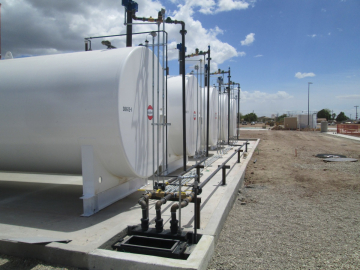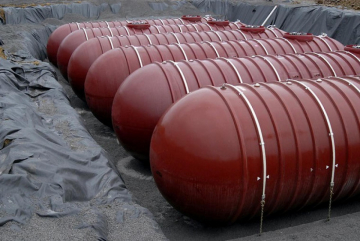From September 13 to 15, Ben Hansen, Chris Meyer, and Gary Diewald attended the 27th National Tanks Conference, in Pittsburgh, Pennsylvania. This conference is particularly centered around Underground Storage Tanks (USTs). They were joined by a few hundred state and federal regulators, UST owners, and tank compliance, operation, and spill remediation service and technology experts. The content that was presented throughout that meeting can be found here.
Here are a few of the insights that they walked away with:
The Impacts of Climate Change
Evolving environmental conditions necessitate a reevaluation of assets and procedures. Depending on where you operate, owners, operators, and service providers need to consider whether the risk of disasters like inland flooding, drought, or wildfires is becoming more likely. This could mean an update to operation and evacuation or shutdown procedures to minimize the effects on your business and the surrounding community. Do employees know what to do in advance or following a disaster event?
It could also mean building contingencies into the design and construction of new operations or remediation infrastructure. Are you prepared for the potential for electrical outages or the increase in corrosion that may arise from areas prone to extreme heat or thermal flux? With these considerations could also come unanticipated compliance requirements, such as the need to permit and monitor tanks that are used to supply fuel to an emergency generator.
The best advice is to pause and take a moment to re-evaluate the environmental settings of the operations, as conditions may have changed. The EPA’s UST Finder can help you determine the location of your USTs relative to floodplains and fire burn areas. The EPA has a useful Flood Guide and the National Drought Mitigation Center at the University of Nebraska-Lincoln has collaborated with the United States Department of Agriculture, and the National Oceanic and Atmospheric Administration to develop the US Drought Monitor.
State Fund and Financial Assurance Update
A very important tract during the National Tanks Conference dealt with aging tanks and the state of available financial responsibility mechanisms. Challenges that regulated and regulating communities are dealing with include securing financial assurance for aging tank systems (the average age of a UST in the USA is 26 years), rising remediation costs, and the declining trend of state fund income deriving from the decline in gasoline sales due to the country and auto industry transitioning away from the internal combustion engine in favor of electric vehicles.
The EPA and state agencies are taking this matter seriously and have developed a renewed focus on solving this issue collaboratively with private industry and have provided new guidance and resources online. The EPA has provided resources for dealing with aging tanks.
Another valuable resource that has been made available online is the Annual State Fund Survey and Tank Update provided by the Association of State and Territorial Solid Waste Management Officials (ASTSWMO) along with the Vermont Department of Environmental Conservation.
Funding for Tank Upgrades
The current average age of registered USTs is 26 years old. It is currently estimated that more than 35% of all registered USTs are more than 30 years old, with that number expected to be more than 75% in the next 10 years. Often these ages also apply to tank appurtenances such as piping, fittings, etc. While release frequency isn’t always related to tank age, this liability cannot be ignored.
Tank age can also create challenges with compatibility, as new fuels move into the market. While tank age also factors into the costs to obtain insurance, the reality is that upgrades for many owners/operators are a costly investment that they may not have the means to address. As a result, many states have tank closure incentives or loan/grant programs to support the decision to upgrade. The EPA released a resource guide to help locate funding sources to assist in this endeavor.
UST Inspection and Maintenance
A significant portion of the conference was devoted to UST inspection, testing, and maintenance of which tank overfill prevention was a recurring theme. UST owners/operators are still experiencing overfills. As one presenter put it, “Overfill Prevention: We still can’t get it right!” Why is this the case? One reason is that although inspections are occurring, overfill prevention devices are not being properly inspected for functionality.
In order to properly inspect these devices for functionality, they must be removed from the tanks and tested. These devices include flapper valves, ball float valves, high-level alarms, and line leak detectors. Flapper and ball float valves must be removed to determine whether the floats are stuck in the riser or missing. High-level alarm floats should also be removed and tested. This testing should include confirmation of shutoff and alarm set levels which are typically 90-95% for mechanical shutoff and 90% for alarms. These set points are regulated by Federal and State UST programs.
Is Your Tank System Properly Permitted
EPA and private sector presentations both focused on determining whether a tank system was permitted as a UST or AST system based on the EPA’s UST rule: Code of Federal Regulations, 40 CFR Part 280, which states, “An underground storage tank (UST) system is a tank (or a combination of tanks) and connected underground piping having at least 10 percent of their combined volume underground. The tank system includes the tank, underground connected piping, underground ancillary equipment, and any containment system.”
Owners/operators of large tank systems, with either aboveground or underground tanks, should complete the calculations needed to determine if their system qualifies as a UST system under the 10 percent rule. Even ASTs connected to these systems which have a significant volume of underground piping can be a UST system and need to be permitted under the Federal 40 CFR 280 or State 40 CFR 281 UST regulations. The EPA has provided an online resource for guidance on making this calculation under the UST Technical Compendium.
In Summary
Climate change poses new risks to tanks all around the US, and that’s something owners/operators of these tank systems need to prepare for. The EPA has provided new resources to ensure owners/operators have state funds and financial assistance available for addressing aging tanks. Overfills are still happening, and that’s why it’s important to ensure your overfill prevention devices are working. You have to test them for functionality. Finally, as an owner/operator, it’s your job to determine if your tank system qualifies as a UST system and get it properly permitted. Staying on top of these things and continuing to have conversations around them should bring more awareness to owners/operators and help them maintain their important tank assets.
Please reach out to Chris Meyer, Ben Hansen, and Gary Diewald with your thoughts or questions and let’s keep this conversation going!
For help managing your UST tank system, reach out to our Spill and Response Plans team or our Risk and Financial Services team.
Want more news and insights like this?
Sign up for our monthly e-newsletter, The New Leaf. Our goal is to keep you updated, educated, and even a bit entertained as it relates to all things EHS and sustainability.
Have any questions?
Contact us to discuss your environment, health, safety, and sustainability needs today.






